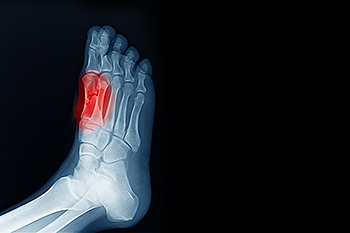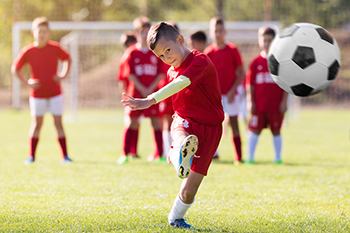Columbus: (614) 866-2477
Gahanna: (614) 939-9330
Lancaster: (740) 653-2656
Newark: (740) 344-8286
North Gahanna: (614) 478-2111
East Columbus: (614) 235-2323
Westerville: (614) 939-9330
Dublin: (614) 339-2000
Pickerington: (614) 545-4321
Lancaster: (740) 653-2656
Items filtered by date: November 2022
Treating Sesamoiditis

Sesamoiditis is a particular kind of foot affliction that primarily affects the sesamoid bones near the big toe. The sesamoid bones are two small bones located beneath the big toe joint, and when they become inflamed, a condition known as sesamoiditis can develop. There are several ways in which one with sesamoiditis might go about treating this condition. For example, someone with sesamoiditis might try making adjustments to the kind of footwear that they are wearing. Taking this step might help alleviate pain. Opting to wear shoes that have more cushioning in the affected area might be beneficial. Additionally, wearing custom orthotics in the shoes can help further reduce pain and mitigate the condition. Besides making adjustments to the shoes that one wears, one might also consider adjusting their daily physical activities, excluding those that put extra strain on the affected sesamoid bones. Contact a podiatrist today for more information.
Sesamoiditis is an unpleasant foot condition characterized by pain in the balls of the feet. If you think you’re struggling with sesamoiditis, contact one of our podiatrists of Foot & Ankle Specialists of Central Ohio. Our doctors will treat your condition thoroughly and effectively.
Sesamoiditis
Sesamoiditis is a condition of the foot that affects the ball of the foot. It is more common in younger people than it is in older people. It can also occur with people who have begun a new exercise program, since their bodies are adjusting to the new physical regimen. Pain may also be caused by the inflammation of tendons surrounding the bones. It is important to seek treatment in its early stages because if you ignore the pain, this condition can lead to more serious problems such as severe irritation and bone fractures.
Causes of Sesamoiditis
- Sudden increase in activity
- Increase in physically strenuous movement without a proper warm up or build up
- Foot structure: those who have smaller, bonier feet or those with a high arch may be more susceptible
Treatment for sesamoiditis is non-invasive and simple. Doctors may recommend a strict rest period where the patient forgoes most physical activity. This will help give the patient time to heal their feet through limited activity. For serious cases, it is best to speak with your doctor to determine a treatment option that will help your specific needs.
If you have any questions please feel free to contact our offices located in Gahanna, Newark, Columbus, and Lancaster, OH . We offer the newest diagnostic and treatment technologies for all your foot and ankle needs.
Causes and Treatment of Sever’s Disease

In the first few years of a child’s life, the bones in their feet develop from soft areas of cartilage, known as growth plates. Once the growth plate fully develops, the bones do not grow any further. The heel bone grows until about the age of 15. A child between the ages of 9 and 15 who is physically active may develop a condition known as Sever’s disease. This is simply an imbalance between the growth of the heel bone and the soft tissue. The result is pain around the heel, which is made worse by running or standing on tiptoes. It is nearly impossible to detect Sever’s disease from an X-ray, but the symptoms usually are enough to make an accurate diagnosis. Relief from Sever’s disease comes from ceasing the activity that caused it and resting the foot. Heel pads and splinting at night can help to reduce the pain. For more information about Sever’s disease, please check with a podiatrist.
Sever's disease often occurs in children and teens. If your child is experiencing foot or ankle pain, see one of our podiatrists from Foot & Ankle Specialists of Central Ohio. Our doctors can treat your child’s foot and ankle needs.
Sever’s Disease
Sever’s disease is also known as calcaneal apophysitis, which is a medical condition that causes heel pain I none or both feet. The disease is known to affect children between the ages of 8 and 14.
Sever’s disease occurs when part of the child’s heel known as the growth plate (calcaneal epiphysis) is attached to the Achilles tendon. This area can suffer injury when the muscles and tendons of the growing foot do not keep pace with bone growth. Therefore, the constant pain which one experiences at the back of the heel will make the child unable to put any weight on the heel. The child is then forced to walk on their toes.
Symptoms
Acute pain – Pain associated with Sever’s disease is usually felt in the heel when the child engages in physical activity such as walking, jumping and or running.
Highly active – Children who are very active are among the most susceptible in experiencing Sever’s disease, because of the stress and tension placed on their feet.
If you have any questions, please feel free to contact our offices located in Gahanna, Newark, Columbus, and Lancaster, OH . We offer the newest diagnostic and treatment technologies for all your foot and ankle injuries.
What Is Tennis Toe?

Tennis can be fun, but as with most sports, injuries can happen. The most common injury to the lower extremities from tennis is tennis toe. Tennis toe is considered the most painful injury one can experience from this sport. It is often also referred to as runner’s toe. Tennis toe is caused by pressure on the toe which causes blood to collect in the nail of the toe. It happens when a player is continuously moving around, jumping, or stopping. It can also develop from wearing shoes that do not fit well and cause the toe to rub against the shoe resulting in pain. If you play tennis and feel pain in your toes that persists or if your nail has turned purple or blue, contact a podiatrist who can offer you proper treatment.
Ankle and foot injuries are common among athletes and in many sports. They can be caused by several problems and may be potentially serious. If you are feeling pain or think you were injured in a sporting event or when exercising, consult with one of our podiatrists from Foot & Ankle Specialists of Central Ohio. Our doctors will assess your condition and provide you with quality foot and ankle treatment.
Common Injuries
The most common injuries that occur in sporting activities include:
- Achilles Tendonitis
- Achilles Tendon Rupture
- Ankle Sprains
- Broken Foot
- Plantar Fasciitis
- Stress Fractures
- Turf Toe
Symptoms
Symptoms vary depending upon the injury and in some cases, there may be no symptoms at all. However, in most cases, some form of symptom is experienced. Pain, aching, burning, bruising, tenderness, tightness or stiffness, sensation loss, difficulty moving, and swelling are the most common symptoms.
Treatment
Just as symptoms vary depending upon the injury, so do treatment options. A common treatment method is known as the RICE method. This method involves rest, applying ice, compression and elevating the afflicted foot or ankle. If the injury appears to be more serious, surgery might be required, such as arthroscopic or reconstructive surgery. Lastly, rehabilitation or therapy might be needed to gain full functionality in the afflicted area. Any discomfort experienced by an athlete must be evaluated by a licensed, reputable medical professional.
If you have any questions, please feel free to contact our offices located in Gahanna, Newark, Columbus, and Lancaster, OH . We offer the newest diagnostic and treatment technologies for all your foot care needs.
Obesity and Plantar Pressure

Obesity can affect many different aspects of one’s health, including the health of the feet. When an individual gains a significant amount of weight, they essentially place more weight on their feet when standing and engaging in physical activity. If you are an obese individual, then it is possible that you might be putting yourself at a higher risk of experiencing some kind of increased plantar pressure. Plantar pressure is defined as the field of pressure found in between the sole of the foot and a surface during movement. These effects may be even more pronounced for those who are living with diabetes, who are already prone to suffering a number of different foot afflictions. If you find yourself falling into any of these categories, please consult a podiatrist today to schedule an appointment.
Obesity has become very problematic at this point in time and can have extremely negative effects on the feet. If you’re an obese individual and are concerned about your feet, contact one of our podiatrists from Foot & Ankle Specialists of Central Ohio. Our doctors can provide the care you need to keep you pain-free and on your feet.
Obesity and Your Feet
Since your feet are what support your entire weight when standing, any additional weight can result in pain and swelling. Being overweight is one of the main contributors to foot complications.
Problems & Complications
Extra Weight – Even putting on just a few extra pounds could create serious complications for your feet. As your weight increases, your balance and body will shift, creating new stresses on your feet. This uneven weight distribution can cause pain, even while doing the simplest tasks, such as walking.
Diabetes – People who are overweight are at serious risk of developing type-2 diabetes, which has a drastic impact on the health of your feet. As you get older, your diabetes might worsen, which could lead to loss of feeling in your feet, sores, and bruises. You could also become more prone to various infections.
Plantar fasciitis – Pressure and stress that is placed on muscles, joints, and tendons can trigger plantar fasciitis, which is an inflammation of tissue that forms along the bottom of the foot.
If you have any questions please feel free to contact our offices located in Gahanna, Newark, Columbus, and Lancaster, OH . We offer the newest diagnostic and treatment technologies for all your foot and ankle needs.
Healthy Eating for Diabetes

There are many questions that arise when you receive a diagnosis for diabetes. “What can I eat?” is one of the most common because it’s easy to feel overwhelmed by the limitations and decisions you have to make. While there is no one correct way, there are some tips that can help you feel empowered in your eating choices while having diabetes and allow you to enjoy all the flavors and foods out there!
1. Work with a nutrition specialist
Our bodies are all different, so it’s important to come up with a plan that is tailored to your specific body and nutrition needs. A registered dietician nutritionist experienced in diabetes planning can help you create a meal plan that works around your treatments and food preferences.
2. Use the Diabetes Plate Method
If counting and calculating calories, macronutrients, and carbs sounds overwhelming, you can use this simple method that helps portion meals.
Step 1: Fill half of a dinner plate with non-starchy vegetables like broccoli, carrots, leafy greens, cucumbers, mushrooms, green beans, and peppers. Not only are they low-carb but they are also filled with beneficial minerals and vitamins.
Step 2: Fill a quarter of the plate with lean proteins like chicken, fish, tofu, cheese, shellfish, hummus, or edamame. Lean animal protein choices are lower in saturated fat which is a better choice for your heart!
Step 3: Fill the last quarter of the plate with carbohydrates like starchy vegetables (potatoes, squash, pumpkin), rice, beans, fruit, and dairy products.
Step 4: Don’t forget to hydrate! Opt for water or other unsweetened drinks
It’s a helpful method when thinking about the overall balance of proteins, vegetables, and carbs in your meal, so you can apply it regardless of whether you’re eating on a plate!
3. Look at food labels
While you don’t want to be obsessing over everything you eat, it’s good to get to know what’s on food labels to help you make the best food choices. The important ones to look at are the serving size, total carbohydrates, including starches, fiber, and sugar. Similar to the plate method, it’s important to prioritize unprocessed, nutrient dense carbs, and high fiber foods over processed, high carb, high sodium, and high saturated fat foods. Have questions about food labels? Ask a registered dietician to walk you through what to look for.
Diabetes and your feet!
What you eat can impact your whole body health, including your feet! Foods rich in vitamin D, calcium, and omega-3s are especially important for your foot health to support healthy bones and tissues. Diabetes impacts your feet in many ways, so consult with our podiatrists to stay on top of your foot health and prevent complications like ulcers, neuropathy, and amputations.
At Foot and Ankle Specialists of Central Ohio, our team of dedicated foot care specialists are experienced in all aspects of diabetic foot care and other podiatric issues. If foot pain is preventing you from living life comfortably, reach out to our podiatrists for help! Contact any of our offices in Columbus, Gahanna, Dublin, Lancaster, Pickerington, and Newark, OH to schedule an appointment today!
Wounds That Don't Heal Need to Be Checked
Can Running Injuries Be Prevented?

Many people who enjoy running are often devastated if they have endured a foot injury. This can cause their running routine to temporarily stop, which may cause despair. The importance of preventing running injuries is crucial among most runners, and there are simple methods that can be done, which can help to do this. A common running injury can happen to the Achilles tendon, which connects the heel to the calf muscles. This may be prevented by performing heel stretches before starting and after completing a run. Additionally, plantar fasciitis can cause severe pain and discomfort, and can be a runner’s worst nightmare. It affects the plantar fascia that is found on the sole of the foot, and connects the heels to the toes. Consistent running without performing stretches beforehand can lead to this debilitating foot condition. A stress fracture can gradually occur from overuse, or may happen from increasing intensity and speed too quickly. If you would like information about how to perform specific stretches that may help to prevent running injuries, please speak with a podiatrist.
Exercising your feet regularly with the proper foot wear is a great way to prevent injuries. If you have any concerns about your feet, contact one of our podiatrists of Foot & Ankle Specialists of Central Ohio. Our doctors will treat your foot and ankle needs.
How to Prevent Running Injuries
Many common running injuries are caused by overuse and overtraining. When the back of the kneecap starts wearing out and starts causing pain in your knee, this is commonly referred to as runner’s knee. Runner’s knee is a decrease in strength in your quadriceps and can occur if you’re not wearing properly fitted or supporting shoes. To prevent runner’s knee, focusing on hip strengthening is a good idea, as well as strengthening your quads to keep the kneecaps aligned.
What Are Some Causes of Running Injuries?
- One cause of a common running injury is called iliotibial band syndrome.
- Plantar fasciitis is also another common injury.
- Stress fractures can occur from overtraining, lack of calcium, or even your running style.
Best Ways to Prevent Running Injuries
- Wear footwear that fits properly and suits your running needs.
- Running shoes are the only protective gear that runners have to safeguard them from injury.
- Make a training schedule. Adding strengthening exercises as well as regular stretching can help keep you strong and limber and can lessen the possibility of injuries.
- Stretching keeps muscles limber; this will help you gain better flexibility.
If you have any questions please feel free to contact our offices located in Gahanna, Newark, Columbus, and Lancaster, OH . We offer the newest diagnostic and treatment technologies for all your foot and ankle needs.
Blog Archives
- April 2024
- March 2024
- February 2024
- January 2024
- December 2023
- November 2023
- October 2023
- September 2023
- August 2023
- July 2023
- June 2023
- May 2023
- April 2023
- March 2023
- February 2023
- January 2023
- December 2022
- November 2022
- October 2022
- September 2022
- August 2022
- July 2022
- June 2022
- May 2022
- April 2022
- March 2022
- February 2022
- January 2022
- December 2021
- November 2021
- October 2021
- September 2021
- August 2021
- July 2021
- June 2021
- May 2021
- April 2021
- March 2021
- February 2021
- January 2021
- December 2020
- November 2020
- October 2020
- September 2020
- August 2020
- July 2020
- June 2020
- May 2020
- April 2020
- March 2020
- February 2020
- January 2020
- December 2019
- November 2019
- October 2019
- September 2019
- August 2019
- July 2019


